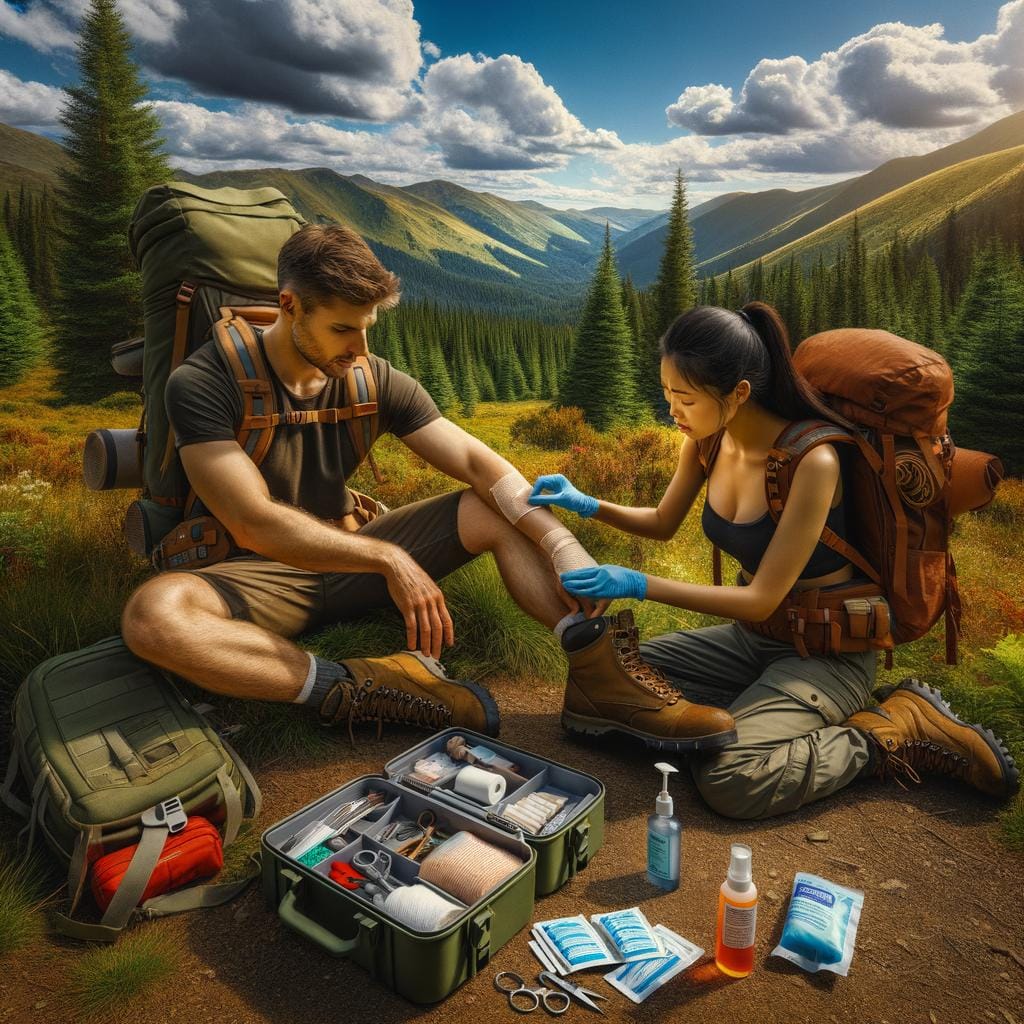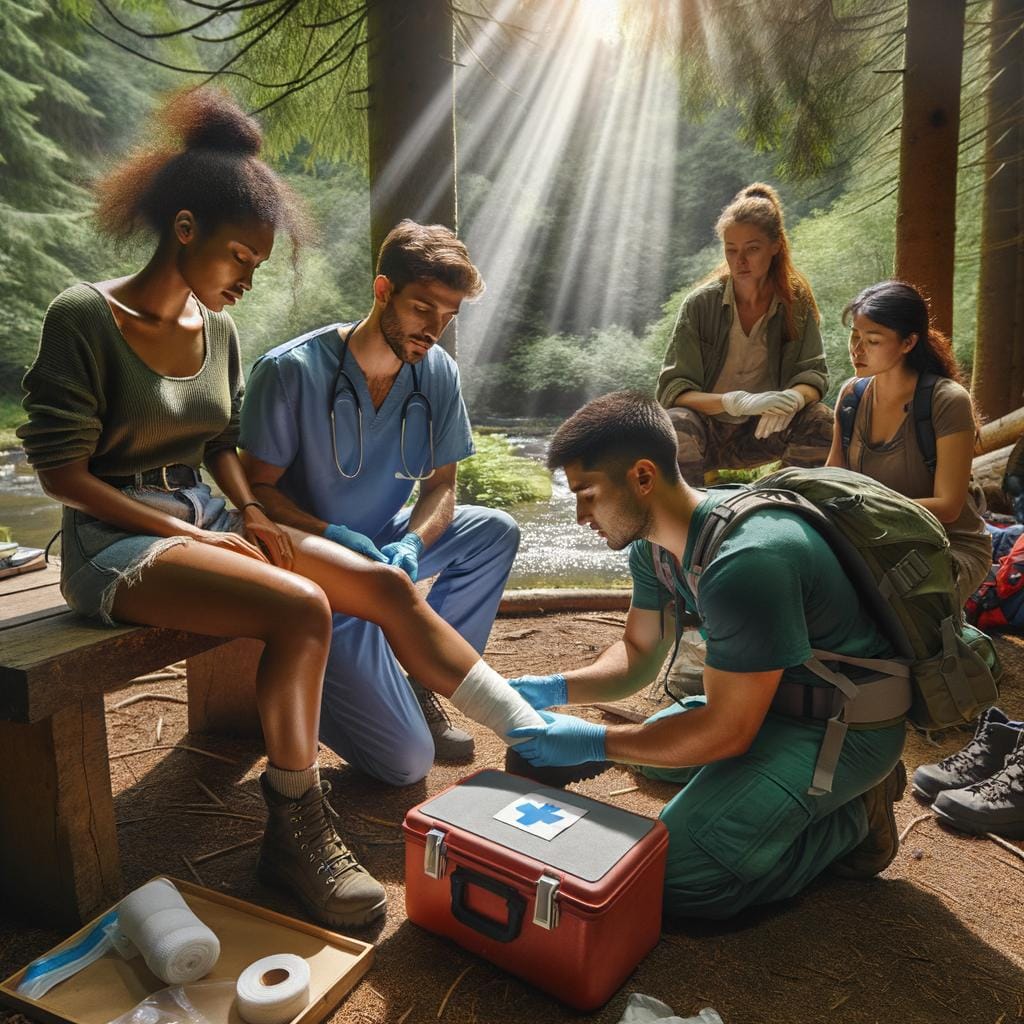Heading out into the great outdoors can be an exhilarating experience, but it also comes with its fair share of risks. Whether you are hiking, camping, or partaking in any outdoor adventure, being equipped with the knowledge of first aid for outdoors is essential. In remote locations where medical help may be far away, knowing how to handle injuries and emergencies can mean the difference between life and death.
Outdoor activities expose individuals to a variety of potential hazards, from cuts and scrapes to more serious injuries like fractures and heat-related illnesses. Understanding the importance of first aid in these situations not only ensures your own safety but also that of those around you. Being prepared with the necessary skills and tools can help prevent minor incidents from turning into major emergencies.
In this comprehensive guide to first aid for outdoors, we will explore common outdoor injuries, preventative measures, essential items for your first aid kit, as well as how to treat various wounds and illnesses while on the trail. From handling bug bites and poisonous plants to recognizing heat-related illnesses and administering CPR in remote areas, this article will equip you with the knowledge needed to stay safe during your outdoor adventures.
Common Outdoor Injuries and How to Prevent Them
Outdoor activities come with a certain level of risk, and being prepared for common injuries that may occur is crucial for any outdoor enthusiast. One of the most frequent injuries in the outdoors is cuts, scrapes, and bruises.
These can happen from a simple fall on the trail or while navigating through rough terrain. To prevent such injuries, it’s essential to wear proper footwear with good traction, stay aware of your surroundings, and avoid running on slippery or uneven surfaces.
Another common injury in outdoor activities is sprains and strains. These can occur when hiking, climbing, or participating in sports like biking or skiing. To prevent these injuries, always warm up before engaging in physical activity, use proper technique when performing tasks that strain your muscles or joints, and wear supportive gear like ankle braces if you’re prone to sprains.
Moreover, insect bites and stings are another prevalent issue when spending time outdoors. Ticks, mosquitoes, bees, and wasps can all cause discomfort or significant allergic reactions.
To prevent bug bites and stings, use insect repellent containing DEET or picaridin, wear protective clothing like long sleeves and pants when hiking through wooded areas, and avoid floral-scented perfumes or lotions that may attract insects. If you do get bitten or stung, knowing how to provide first aid for outdoors is crucial to prevent further complications.
Essential First Aid Kit Items for Outdoor Adventures
When heading out for outdoor adventures, it is crucial to always be prepared with a well-stocked first aid kit. Carrying essential first aid items can mean the difference between a minor inconvenience and a serious emergency. Here are some must-have items to include in your outdoor first aid kit:
Bandages and Dressings
One of the most important components of any first aid kit are bandages and dressings. These are essential for covering wounds and protecting them from dirt and infection. Make sure to have a variety of sizes and shapes to accommodate different types of injuries.
Antiseptic Wipes and Ointments
Cleaning wounds properly is key to preventing infections. Antiseptic wipes or ointments can help disinfect cuts, scrapes, and other injuries in outdoor settings where access to clean water may be limited. Including these items in your kit is essential for proper wound care.
Medications
It’s also important to pack some basic medications in your outdoor first aid kit. Pain relievers, antihistamines, anti-diarrheal medication, and any personal medications you may need should all be included. These can be invaluable in providing relief from common ailments while out in the wilderness.
By ensuring that your first aid kit is well-equipped with these essential items, you can feel more confident when venturing into the great outdoors. Remember that being prepared with the right tools can make all the difference in providing effective first aid for outdoors emergencies.
How to Handle Different Types of Wounds and Cuts in the Outdoors
When exploring the great outdoors, it is important to be prepared for any potential injuries that may occur along the way. Knowing how to handle different types of wounds and cuts in outdoor settings can make a significant difference in the outcome of an emergency situation. Whether it’s a minor scrape or a more serious laceration, being equipped with the knowledge and supplies for first aid in the wilderness is crucial.
To effectively address wounds and cuts in outdoor environments, it is essential to have a well-stocked first aid kit at hand. Some key items to include in your kit are:
- Antiseptic wipes or solution to clean the wound
- Adhesive bandages in various sizes
- Gauze pads and adhesive tape for dressing larger wounds
- Tweezers for removing debris from cuts
- Scissors to cut bandages or clothing if needed
In addition to having the necessary supplies, knowing how to properly clean and bandage different types of wounds is crucial. For minor scrapes and cuts, follow these steps:
- Clean the wound with antiseptic wipes or solution.
- Apply an adhesive bandage to protect the area from dirt and germs.
- Monitor the wound for any signs of infection, such as increased redness or swelling.
For deeper cuts that may require stitches, it is important to apply pressure to stop any bleeding and seek professional medical help as soon as possible. Remember that proper wound care can prevent further complications and promote faster healing when enjoying outdoor activities.
Treating Sprains, Fractures, and Dislocations on the Trail
When out in the wilderness enjoying outdoor activities such as hiking, camping, or rock climbing, injuries like sprains, fractures, and dislocations can occur. Knowing how to properly address these issues is crucial for ensuring a safe and successful outing. In this section, we will delve into the essential knowledge and skills needed to treat such injuries while on the trail.
Identifying Sprains, Fractures, and Dislocations
The first step in providing adequate first aid for sprains, fractures, and dislocations is recognizing the signs and symptoms of each type of injury. A sprain typically involves damage to ligaments around a joint and results in pain, swelling, and limited range of motion.
On the other hand, fractures involve a broken bone that can cause deformity or severe pain upon movement. Dislocations occur when bones are forced out of their normal positions within a joint and often result in visible deformities.
Immediate First Aid Steps
Once you have identified that someone has sustained a sprain, fracture, or dislocation while on the trail, it’s crucial to provide prompt first aid to alleviate pain and prevent further complications. For sprains and minor fractures, remember the RICE method: Rest – Ice – Compression – Elevation.
Give the injured limb adequate rest by immobilizing it with a splint or brace if necessary; apply ice to reduce swelling; use compression bandages to support the injury; elevate the limb above heart level to minimize swelling.
Seeking Help and Evacuation
If you suspect a more serious fracture or a dislocation that requires professional medical attention while outdoors, it may be necessary to seek help from trained rescuers or evacuate the injured person safely. Always carry communication devices like satellite phones or personal locator beacons when venturing into remote areas for quick assistance in case of emergencies. Additionally, having knowledge of basic wilderness first aid can make all the difference in handling more severe injuries until help arrives.
Dealing With Bug Bites, Stings, and Poisonous Plants in the Wilderness
While enjoying outdoor activities, encountering bug bites, stings, and potentially coming into contact with poisonous plants is not uncommon. Knowing how to deal with these situations effectively is crucial for any outdoor enthusiast. Here are some tips on handling bug bites, stings, and poisonous plants in the wilderness:
- Be prepared by carrying insect repellent when heading out into areas where bugs are prevalent. Applying repellent with DEET can help deter insects from biting or stinging you.
- In the event of a bug bite or sting, promptly clean the affected area with soap and water to reduce the risk of infection. Remove any remaining stinger if applicable by scraping it off gently using a blunt object.
- To alleviate itching and swelling from bug bites, consider applying an over-the-counter antihistamine cream or taking an oral antihistamine. This can help to reduce discomfort and inflammation caused by the bite or sting.
When it comes to encountering poisonous plants in the wilderness, such as poison ivy or poison oak, it’s essential to be able to recognize them to avoid direct contact. Here are some tips on dealing with exposure to toxic plants:
- If you suspect you have come into contact with a poisonous plant, immediately wash the affected area with soap and water to remove any oils that may cause a reaction. Avoid scratching as this can spread the irritant.
- Change your clothes if you think they may have come into contact with the plant to prevent further exposure to your skin.
- Consider using calamine lotion or hydrocortisone cream on any irritated skin to help alleviate itching and inflammation. Seek medical attention if symptoms persist or worsen after exposure.
By being proactive about preventing bug bites and stings while also knowing how to handle encounters with poisonous plants, you can enjoy your outdoor adventures more safely and confidently. Remember always to be prepared with a well-stocked first aid kit that includes items specifically for addressing these types of issues in the wilderness.
Recognizing and Managing Heat-Related Illnesses in Outdoor Environments
Heat-related illnesses are a serious concern for outdoor enthusiasts, especially during the hot summer months. Whether you are hiking, camping, or participating in any outdoor activity, it is crucial to be aware of the signs and symptoms of heat-related illnesses such as heat exhaustion and heat stroke. Recognizing these conditions early on can help prevent them from escalating into more severe medical emergencies.
One of the key factors in preventing heat-related illnesses is staying hydrated. Make sure to drink plenty of water before, during, and after your outdoor adventures. Wearing lightweight, light-colored, and loose-fitting clothing can also help regulate your body temperature and reduce the risk of overheating. Taking breaks in shaded areas or during the cooler parts of the day can provide relief from the sun’s intense rays.
In the event that someone in your group shows symptoms of a heat-related illness, it is essential to take immediate action. Move the person to a cool place, preferably indoors or in the shade. Loosen their clothing and have them drink small sips of water or an electrolyte-rich beverage if they are conscious and able to swallow.
If they exhibit signs of heat stroke such as confusion, rapid pulse, or loss of consciousness, seek emergency medical help immediately. Remembering these simple yet effective first aid measures can make a world of difference when dealing with heat-related illnesses in outdoor environments.
| Heat-Related Illness | Symptoms |
|---|---|
| Heat Exhaustion | Heavy sweating, weakness, dizziness, nausea |
| Heat Stroke | Confusion, rapid heartbeat, unconsciousness |
Tips for Administering CPR and Basic Life Support in Remote Areas
Administering CPR and basic life support in remote areas is crucial for outdoor enthusiasts and adventurers. In situations where professional medical help is not readily available, knowing how to provide emergency care can make a significant difference in saving someone’s life. Whether you are hiking in the mountains or camping in a remote wilderness area, being prepared to handle medical emergencies is essential.
One of the first steps in administering CPR and basic life support is to ensure the safety of yourself and the victim. Assess the situation carefully before approaching the injured person and be aware of any potential hazards that may pose a risk to your safety.
Once you have determined that it is safe to assist, check if the person is responsive by tapping their shoulders and asking if they are okay. If there is no response, check for breathing by tilting their head back slightly, lifting their chin, and looking for chest rise and fall.
In remote areas where access to emergency medical services may be limited, it is vital to initiate CPR immediately if the person is not breathing or showing signs of circulation. Begin with chest compressions at a rate of 100-120 compressions per minute, allowing the chest to fully recoil between compressions. Coordinate with another individual present to take turns with rescue breaths along with chest compressions if possible.
Remember that early intervention with CPR can significantly increase the chances of survival for someone experiencing cardiac arrest in an outdoor setting. By being prepared and knowledgeable in administering CPR and basic life support, you can potentially save a life while enjoying nature’s beauty.
Training and Certification Options for Outdoor First Aid Providers
When venturing into the great outdoors, being prepared for any potential medical emergency is crucial. Having the knowledge and skills to provide first aid in outdoor settings can make a significant difference in the outcome of an injury or illness. That’s why it’s essential for outdoor enthusiasts, guides, and anyone spending time outside to consider training and certification options for outdoor first aid.
One of the most recognized organizations providing training for outdoor first aid is the Wilderness Medical Associates International (WMA). WMA offers a variety of courses specifically tailored to individuals who spend time in remote environments, such as wilderness first aid, wilderness advanced first aid, and wilderness EMT courses. These programs cover topics ranging from wound care to managing environmental emergencies, equipping participants with the necessary skills to handle medical situations when traditional help is not readily available.
In addition to WMA, other organizations like the American Red Cross and National Outdoor Leadership School (NOLS) also offer training courses geared towards outdoor first aid. These programs often combine hands-on practice with theoretical knowledge, ensuring that participants are well-prepared to deal with medical emergencies in the outdoors. By investing time in gaining proper training and certification, individuals can feel more confident and competent in providing life-saving care when needed on their next outdoor adventure.
Real-Life Examples of Outdoor First Aid Situations and Rescues
In conclusion, first aid for outdoor activities is not just a recommended skill but an essential one for anyone participating in adventures in the wilderness. The importance of being prepared to handle common outdoor injuries such as wounds, cuts, sprains, fractures, and heat-related illnesses cannot be overstated. By having the necessary knowledge and tools readily available in a well-equipped first aid kit, individuals can effectively address emergencies that may arise while out in nature.
Being mindful of preventive measures to reduce the risk of injuries and illnesses in outdoor environments is crucial. Recognizing potential hazards such as poisonous plants, bug bites, stings, and knowing how to deal with them can make all the difference in ensuring a safe outdoor experience. Additionally, understanding how to administer CPR and basic life support techniques can be lifesaving in remote areas where professional help may be far away.
Overall, investing time in training and certification for outdoor first aid providers can greatly enhance one’s ability to respond confidently and efficiently during emergency situations. By learning from real-life examples of outdoor first aid situations and rescues, individuals can gain valuable insight into best practices and effective strategies for handling emergencies in the wild.
Remembering to prioritize safety and preparedness before embarking on any outdoor adventure is key to enjoying nature responsibly while being ready to respond effectively if needed.
Frequently Asked Questions
How Do You Do First Aid in the Wild?
In the wild, first aid is crucial for addressing injuries and illnesses when medical help is not readily available. It involves assessing the situation, stabilizing the injured person, managing any immediate threats to life, and providing basic care such as wound cleaning, bandaging, and CPR if needed.
Knowing how to improvise with available resources like branches for splints or clothing for bandages is also essential.
Is Wilderness First Aid Worth It?
Wilderness First Aid (WFA) training is definitely worth it for anyone who spends time in remote outdoor settings. It equips individuals with the knowledge and skills to respond effectively to medical emergencies in the wilderness where professional help may be hours or days away.
WFA courses cover topics such as patient assessment, trauma care, environmental emergencies, and improvised treatments using limited resources—all of which are invaluable when accidents happen off-grid.
What Is the Difference Between WFR and WFA?
The main difference between Wilderness First Responder (WFR) and Wilderness First Aid (WFA) lies in the depth of training and scope of practice. WFR certification requires more comprehensive training, typically lasting 70-80 hours compared to the 16-20 hours of WFA courses.
WFRs are trained to handle more serious medical issues and provide extended care over a longer period until evacuation is possible, while WFAs focus on immediate stabilization and short-term treatments for less severe injuries or illnesses that can be managed until further help arrives.

An avid outdoor enthusiast, writer, and environmental advocate who has spent over two decades exploring the world’s most breathtaking landscapes. With a background in environmental science and a passion for adventure, Frances combines her love for nature with her talent for storytelling to inspire others to embark on their own outdoor journeys.



